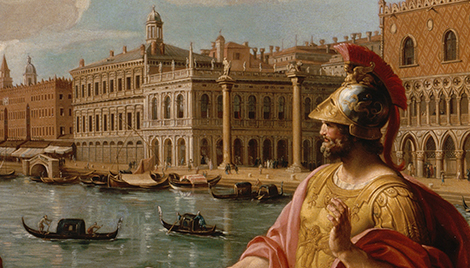Williams College Museum of Art Develops New Ways to Explore Their Collection
The Williams College Museum of Art (WCMA) received a $10,000 grant from the Samuel H. Kress Foundation in 2018 for the development of a Collection Explorer tool that would provide users with new ways to browse and discover the Museum’s collection online. The following description of the Collection Explorer project has been taken directly from the final report submitted by the WCMA, prior to the launch of the interface.
The Collection Explorer interface allows users to browse the WCMA's collection by color (as seen in this screenshot) as well as visual similarity.
Collection Explorer provides a new view of WCMA's collection, tailor-made for visual browsing and discovery. The Collection Explorer visual interface was created to enable faculty and students from a wide range of disciplines and academic departments to use the Museum’s collection in new ways and to find appropriate works of art to use in the study of various disciplines. The new interface may be especially useful to those who are not familiar with the WCMA’s collection, who are without a background in art and art history, or who may not know what keywords to use in a text search. The Collection Explorer interface does not replace WCMA's online catalogue, but is a complementary portal: a tool that rewards visual browsing, where every object has basic metadata and a link to other deeper pathways in the online catalogue.
Visual Browsing
The primary design element on most traditional online collections is the search box; users are expected to enter a keyword in order to get access to a subset of collection records. These online collections are optimized for search which means that users who prefer to browse are left scrolling through page upon page of thumbnails. Collection Explorer affords a view of the entire collection image database from the start, without the barrier of a search box. A familiar pan-and-zoom interaction model – commonly used in online maps – allows the user to move seamlessly from a bird's-eye view of 12,400 objects to a high-resolution view of a single object. Clicking on an individual object zooms in on it and reveals a panel with basic metadata and a link to the object page. Visual browsing using this model means panning across a two-dimensional field of images, like a map or a curator's table, zooming in to focus on objects of interest, then stepping back again to continue exploring.
Collection Explorer presents users with a bird's-eye view of the WMCA's collections, grouped by color or visual similarity (as seen in this screenshot), that they can browse by zooming in and out.
Searching by Image
The visual similarity view in Collection Explorer lays out a landscape of collection images organized by visual similarity. An island of bright-colored hard-edged abstraction, for example, sits across from a sea of portraits new and old. A cluster of round coins and objects sits not far from an area full of dense black and white photos. Each individual work of art is surrounded by others that share visual dimensions, as determined by an algorithm.
Interactive Data Visualization
Across the top of the screen is a simple list of object types in which a larger font size reflects a larger number of artworks in that category. Hovering over a keyword highlights relevant objects in the view. Clicking on a keyword changes the view; all but the relevant objects playfully scatter out of the way, allowing a user to focus on a subset of images. A supplemental search function works similarly by filtering objects in the view as you type.
In Collection Explorer's visual similarity view, objects can be further filtered by medium.
The interactive elements give a sense of the shape of the collection (i.e. mostly prints, many photographs, relatively few paintings). Filtered views also allow for more focused browsing when seeing the whole collection might feel overwhelming. Finally, the animation contributes to a sense of lightness, adaptability, and play. The sense that the collection is alive, dynamic, and malleable is a catalyst for seeing and using the collection in new ways.
Design & Development
To build Collection Explorer, WCMA engaged Micah Walter Studio LLC (MWS) as a technical partner to develop research prototypes and data workflows. MWS helped test and evaluate several existing frameworks and prototyped custom solutions.
WCMA handled project management and user testing internally. WCMA's Digital Project Team includes Collection Developer Jim Allison, Postdoctoral Fellow for Digital Humanities Beth Fischer, Associate Registrar Rachel Tassone and Mellon Manager of Digital Initiatives Chad Weinard. The team tested the tool with faculty, students, and staff. These interactions confirmed the usefulness of a visual approach to browsing the whole collection, guided the kinds of filtering that might be helpful, and inspired the Digital Project Team to think about how such a tool might be used by other museums.
Collection Explorer is now live on the WMCA’s website: http://wcma-explorer.williams.edu/



